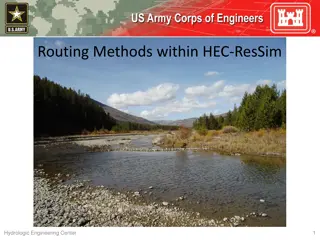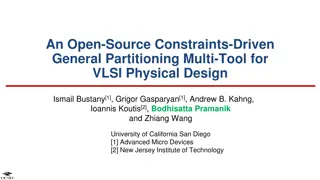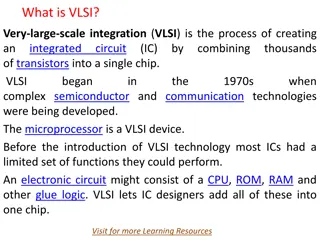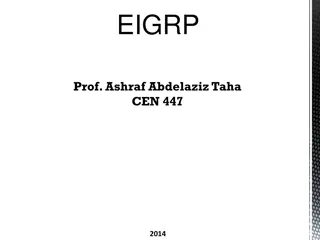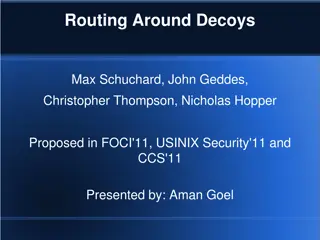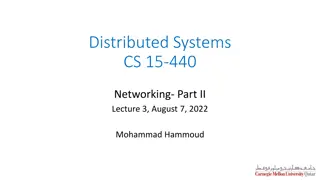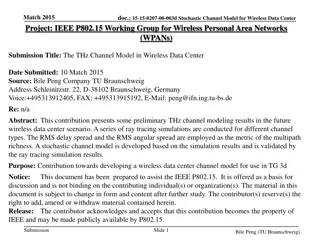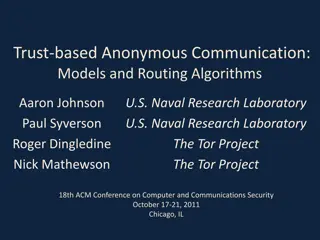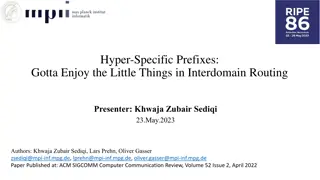VLSI Channel Routing
Explore VLSI channel routing challenges, types of VLSI channels, and constraints involved. Learn about graph problems like Minimum Clique Cover and their application in VLSI channel routing.
Download Presentation

Please find below an Image/Link to download the presentation.
The content on the website is provided AS IS for your information and personal use only. It may not be sold, licensed, or shared on other websites without obtaining consent from the author.If you encounter any issues during the download, it is possible that the publisher has removed the file from their server.
You are allowed to download the files provided on this website for personal or commercial use, subject to the condition that they are used lawfully. All files are the property of their respective owners.
The content on the website is provided AS IS for your information and personal use only. It may not be sold, licensed, or shared on other websites without obtaining consent from the author.
E N D
Presentation Transcript
VLSI Channel Routing By Santhosh Reddy Katkoori
Outline Real World Problem VLSI Channel Description Types and Constraints of VLSI Channels Which Graph Problem? Two Terminal Net MCC1 Algorithm Multi Terminal Net References
Real World Problem Channel Routing Problem in a VLSI Physical design is to compute feasible minimum area routing solution.
VLSI Channel Description Has two open ends (Left & Right side of channel). Other two sides (Upper & Lower) have two row of terminals. A set of terminals that need to be connected together is called NET. The terminals of the same net are assigned with equal numbers. Unconnected terminals are assigned number 0.
Types of VLSI Channels We consider two types of Channels: Two Terminal Net Channel.
Types of VLSI Channels Multi Terminal Net Channel
Constraints in VLSI Channel Our Motto is to assign more non overlapping intervals to same track. We consider both Horizontal and Vertical Constraints. Horizontal Constraints determine weather the intervals can be assigned to same track or not. Vertical Constraints determine the order in which intervals must be assigned from top to bottom. For Representing Horizontal Constraints we construct HCG (Horizontal Constraint Graph). For Representing Vertical Constraints we construct VCG (Vertical Constraint Graph).
Which Graph Problem? This problem can be solved by Calculating Minimum Clique Cover. Minimum Clique Cover is NP Complete [Garey and Johnson 1979] Can be solved in Polynomial Time if the graph is perfect [Golumbic, 1980; Ramierz Alfonsin and Reed 2001]
Two Terminal Net Constructing HCG for Two Terminal Net:
Two Terminal Net HCG gives overlapping intervals; but our aim is to assign non overlapping intervals; so find the complement of HCG Complement of HCG is HNCG(Horizontal Non Constraint Graph)
Two Terminal Net HNCG is Comparability Graph. So, we apply MCC1 Algorithm on HNCG to compute a minimum clique cover of HNCG. Clique corresponds to a set of non overlapping intervals. Main Property of Comparability Graph is Transitively Orientable.
MCC1 Algorithm First: We assign a set of n natural numbers to the vertices of a graph based on starting column positions of all n nets in the channel.
MCC1 Algorithm Second: Then we orient an edge {Vi, Vj} of this graph Vi is having number p and Vjis having number q if (p < q) Vi Vj else Vj Vi
MCC1 Algorithm Third: Start computing cliques. In the first clique, we first include the vertex whose corresponding net is starting first in channel Clique1: {V5,V3,V8} Clique2: {V2, V1} Clique3: {V6, V7} Clique4: {V4}
Solution Assign the cliques to the tracks.
Multi Terminal Net HCG Construction:
Multi Terminal Net VCG Construction
Multi Terminal Net HNCG Construction
References Graphs The Tool to Visualize the problems in VLSI Channel Routing [ISSN 0975-2773] Achira Pal, Tarak N Mandal and Rajat K Pal. http://en.wikipedia.org/wiki/Comparability_graph Golumbic, 1980; Ramierz Alfonsin and Reed 2001

 undefined
undefined





